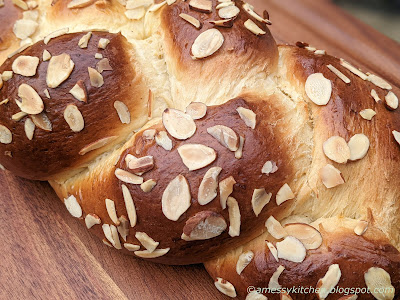Tsoureki (Traditional Greek Easter bread)
makes 1 large braid
12g dry yeast
55g lukewarm water
1.5g ground mastic
5g ground mahleb
67g butter at room temperature
115g sugar
150g milk, at room temperature
2 medium eggs, at room temperature (~100g raw)
435g strong white (bread) flour
zest of 1 orange
For garnish
1 egg and 1 tbsp water
almond slivers
In a bowl, activate the yeast by stirring into the lukewarm water with a pinch of sugar. Cover and set aside for about 6-7 minutes until the yeast is bubbly. Water that is too warm will kill the yeast and too cold will significantly extend the rise time. Around body temperature should do.
Use a pestle or a spice grinder to grind the mastic and mahlab/mahlepi, along with a pinch of the sugar and set aside. Do not add any more mastic than the recipe calls for or it will leave a slightly bitter taste to the bread. The amount is small and subtle, but enough for the distinctive aroma and flavor.
In a saucepan over low heat, stir together the butter, sugar and milk until the sugar is dissolved and the butter is melted. Allow to cool to lukewarm. No more than 110ºF.
Pour the butter mixture in a large bowl and whisk in the eggs.
In the bowl of a stand mixer, add the flour, salt, the ground mastic and mahlepi, orange zest and the butter-egg mixture, and the activated yeast. Using the dough hook mix on low speed until the ingredients start to combine and then on medium-high speed for about 15 minutes, until the dough doesn’t stick to the sides of the bowl while mixing. The dough will be soft and somewhat sticky. Do not add more flour, it is meant to be a soft dough.
Cover and place in a warm area, until the dough is at least doubled in size (about 3-4 hours). If the kitchen is cold, preheat the oven for 30 seconds, turn it off and place the bowl inside with the light on.
Gently deflate the dough and cut in 3 equal portions. Take one piece of the dough (do not flour the working surface!) and roll it a little with your hands. Hold the rope up from the edges and give a little bounce to stretch the dough into a rope. This technique helps form the characteristic stringy texture.
Braid the three pieces together and transfer on a large baking tray layered with parchment paper. Let the braid rise for about 1 more hour at room temperature or in the oven, until it puffs up and almost doubles in size.
In a small bowl whisk together the egg and 1 tbsp water with a fork. Brush the top of the loaf with the egg mixture, taking care not to deflate it, then garnish with almond slivers. Bake in preheated oven at 325ºF for about 30-40 minutes, until nicely browned and fluffy. Cover with foil or parchment if it is getting too brown too quickly, and continue baking.
Let the bread cool down completely and store in a bread bag to keep it from drying out. Store for up to 3 days at room temperature or up to a couple of months in the freezer.
- Chocolate Bunny Bread by A Day in the Life on the Farm
- Choreg-Armenian Easter Bread by Sneha’s Recipe
- Greek Tsoureki by A Messy Kitchen
- Jidase by Magical Ingredients
- Orange Blueberry Hot Cross Buns by Karen’s Kitchen Stories
- Sourdough Carrot Cake Waffles with Cream Cheese Syrup by Food Lust People Love
- Sourdough Choreg-Armenian Easter Bread by Zesty South Indian Kitchen
We take turns hosting each month and choosing the theme/ingredient.






.png)

Beautifully baked and braided bread!
ReplyDeleteThank you!
DeleteI actually have some mahlab! (Of course I do... ) Your bread is so gorgeous.
ReplyDeleteActually, your Shubbak el-Habayeb from 2017 was the reason I got it in the first place! But I have used it in other breads and baked goods since then. Yum.
DeleteI have not heard of those spices but I would love to try them in this bread.
ReplyDeleteYou might be able to find the mahlab in a middle eastern grocery, a good option for assurance of a fresh spice. I like using it in any baked goods where you might like an almond flavor or in place of another sweet spice. The mastic is very interesting and I have enough to last me years but am glad I got it to try out. Now to find other recipes in which to use it!
DeleteTsoureki looks delicious my favorite bread. I love them.
ReplyDeleteI understand why you like it, lovely flavors.
DeleteI love the way the braids rise and separate with the almonds on the raised bits. So pretty!
ReplyDeleteFabulous bread! Love the texture and flavor! I am trying this bread after I get the mastic and mahleb. Their flavor sounds absolutely yummy!
ReplyDelete